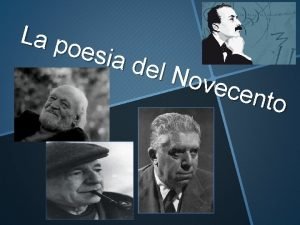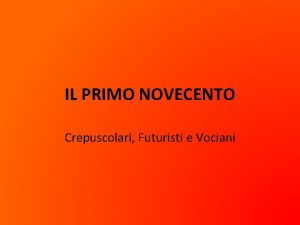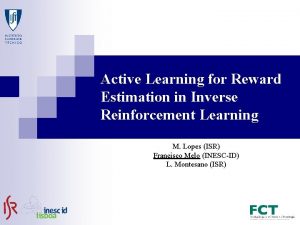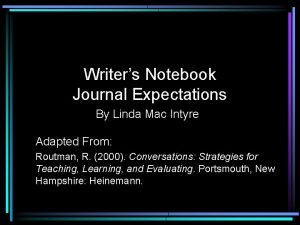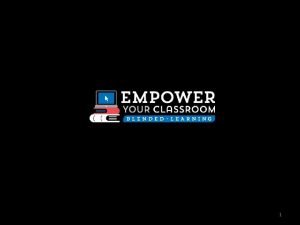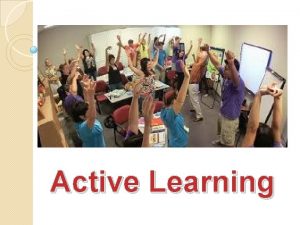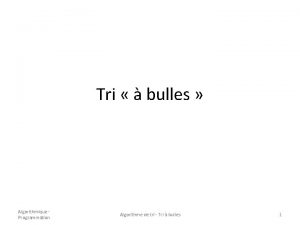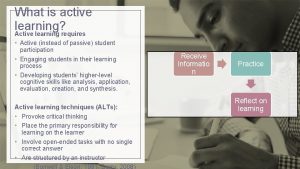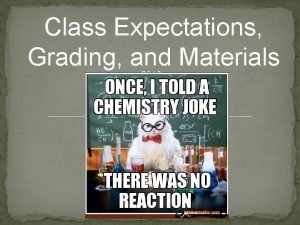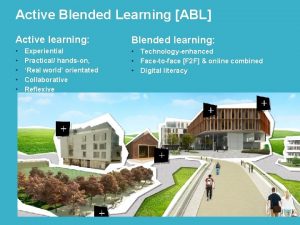Active Learning Writing Expectations and Assessment TRI method








- Slides: 8

Active Learning Writing Expectations and Assessment TRI method Final Project Defined Writing 101 1 Last Thing

Active Learning and Assessment • Assessments for the course consist of OPEN RESPONSE Questions (what – why – how) • Answers must be ALL of high quality to get ALL of the points (TRI) *Open Response Questions measure both what you know and what you can and will do with this knowledge (Active Learning) • Responses are reflections on Coaching • Assignment are NOT ESSAY’s = They are Portfolio’s *Essay Questions measure only what you know – Portfolio tells us how you will apply the research and information you have learned • Assignments = scaffold technique to Portfolio *sequence of tasks that build toward final project

Final Project Defined What is a coaching portfolio? • A tool that provides a potential employer insight on you as a coach and a person (working resume) • The Portfolio should be a direct reflection of your leadership and management philosophies on building a quality athletic program (collection of sample work) • The Portfolio should be a direct reflection of you and your philosophies on ethics, sport, teaching, coaching and life • The Portfolio should provide a look at how you would build your own program If you were the head coach (HC) • The Portfolio should contain information that shows-demonstrates-supports your philosophies (Illustrations) • The format needs to be bold (follow rubric order – easy to follow), yet detailed in content (what – why – how) • MUST use Headers (for each section) –easy on the eyes

Writing 101 • TRI method T = Thesis (main point or your position) *WHAT R = Reinforce or Reference (support) *WHY I = Illustrate (example – visual / story / etc…) *HOW

Thesis • What is a Thesis Statement? • A thesis statement is a sentence that articulates your main point. It should be clear, concise, arguable, and present your position. The writing assignments (see rubrics) for this class should start with a thesis statement addressing each section.

How to write a Thesis Statement • A thesis statement should not “announce” your topic, but should provide a point of view that you will defend in your portfolio. This does not mean it should just be an opinion statement – it should be an argument that you support with evidence (R and I) • Ideally, you should sum up argument in 1 sentence (make it stick with your audience) • Best to start (each section of rubric) with Thesis

How to start designing Thesis • #1 – do your research (readings + notes) • #2 – start in reverse order • Example – figure out what you will use to Reinforce (references) and Illustrations = Evidence you will use to design your Thesis Statement (KEEP an OPEN MIND) – might gain a new perspective or learn something new! • Once you have an idea for your Thesis – go back to the Rubric and read instructions – make sure Thesis FITS what rubric asks for

1 Last Thing • Can my Thesis change? • Absolutely – when you finish writing your assignment – revisit your thesis statement(s) and see if they connect to one-another • TEST #1 – it should be easy to pick out Thesis #2 – it should have a stickiness to it #3 – Remember TRI method (support position)
 Licenze poetiche palazzeschi
Licenze poetiche palazzeschi La fontana malata scuola primaria
La fontana malata scuola primaria Active and passive learners
Active and passive learners Inverse reinforcement learning
Inverse reinforcement learning Passive voice examples
Passive voice examples 3 to 8 decoder truth table
3 to 8 decoder truth table Membrane structures that function in active transport
Membrane structures that function in active transport Cuadro comparativo entre e-learning b-learning y m-learning
Cuadro comparativo entre e-learning b-learning y m-learning Journal writing expectations
Journal writing expectations
